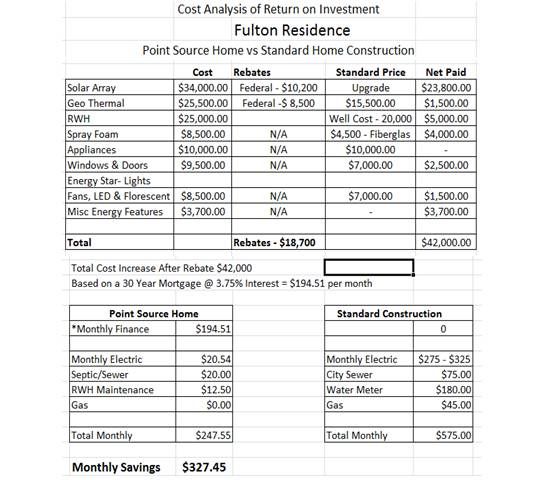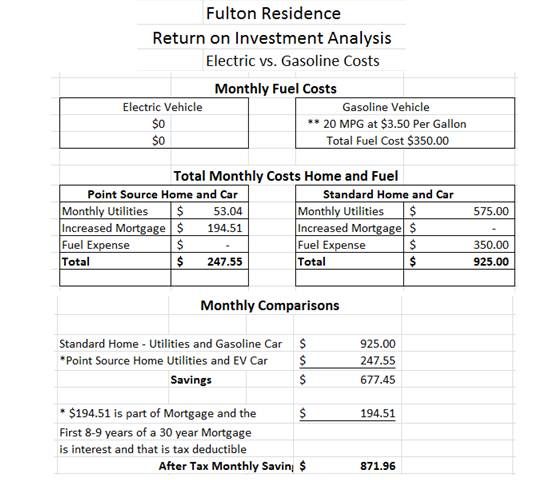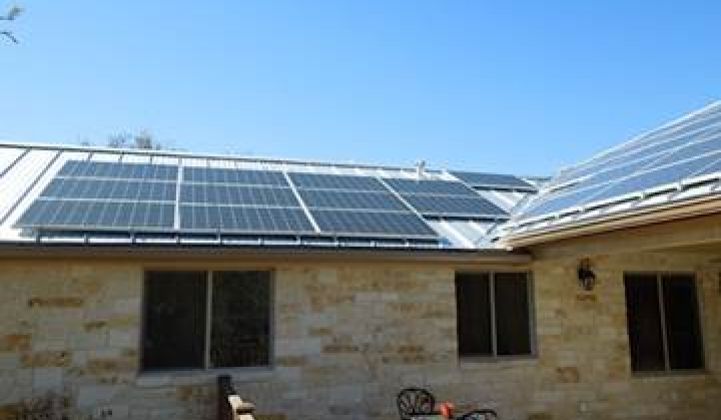Sustainable Homes of Texas President Darrel McMaster calls the house he built last year in the Texas hill country outside San Antonio “the greenest house in America” because it received the highest verified green building standard score ever given by the National Association of Home Builders.
After rebates, the cost of that green score was approximately 9.5 percent above the house’s market price. “Their house was about $450,000,” McMaster said. “They had to increase their mortgage around $42,000.” But that’s not the whole story, he insisted.
“Dr. Fulton is a math professor at Texas State. He ran the numbers,” McMaster explained. The numbers: $871.96 in utility and fuel cost monthly savings means the $42,300 mortgage increase will be paid off in 48.5 months. And according to Dr. Fulton, McMaster reported, since the first eight to nine years of any 30-year mortgage is interest, the roughly $200 per month mortgage increase will pay off well within the time that the money is entirely tax deductible.
“It’s just a win-win situation when you see these numbers,” McMaster said, which is why he says his business “hasn’t been this good for us in five or six years,” adding that “people are standing in line.”
McMaster said he initially thought his customers would be environmentalists. Instead they were typically independent Texans declaring, “‘I want my own water and my own power.’” But in the last two years, his customers have become “people like the Fultons that we call the economists” who “are starting to see that a house like this makes financial sense.”

The Fultons’ house features rainwater harvesting that provides 100 percent of the family’s water, even in the drought-plagued Texas hill country. It also has an onsite wastewater treatment system. Unlike many states, McMaster said, Texas regulations facilitate the use of these cutting-edge technologies.
The house also has an 8.9-kilowatt rooftop photovoltaic solar system that, with Texas’ net metering, provides the all-electric house with its entire electricity needs. The solar system has no battery storage, McMaster explained, because net metering allows the grid to serve as storage.
The Fultons pay a connection fee of $20.54 per month. They send the electricity they don’t use during the day -- often during periods of peak demand when electricity rates are highest -- to the grid. When there is no sun, they draw from the grid. On net, they have not paid for electricity usage since moving in, despite keeping Fulton’s LEAF charged through the Eaton Level Two Charger built into the garage. And, McMaster added, Fulton is amused about rising gas prices.
The house has a geothermal heat exchange heating and cooling system that moderates the temperature of the house and its water system, significantly reducing ambient heating and cooling and hot water heating needs.
Foam insulation and special doors and windows further minimize ambient heating and cooling needs, but also present an associated concern.
“When you build a house really tight, you have a very tight envelope,” McMaster said. “Instead of opening a window, we have an Energy Recovery Ventilator [ERV], a metal box in the attic, that allows us to change the air in that house up to two times a day.” The ERV moderates the temperature and humidity of incoming air to reduce its impact on the ambient indoor temperature. It also helps cleanse allergens and pollutants.

McMaster said he has been building homes for 36 years and has long known he could build net-zero homes. The problem was return on investment. “Your grandchildren would probably be the first people to see any kind of break-even point.”
The dropping price of solar, which McMaster said he has been installing since the 1980s, has helped. But the key has been the 30 percent federal tax credits on solar and geothermal systems.
He explains the incentives Texas-style: “These rebates aren’t the government giving us money,” he tells customers. “It’s not a Solyndra deal where they’re writing us a check. These are tax rebates. This is your money.”
McMaster said the houses sell to customers across the political spectrum. “We go from far-left people to the far right and what they all agree on is one thing: building houses that make financial sense, whether it’s good for the environment or good for their pocketbook.”
McMaster’s experience provides some perspective. “Technology has changed so radically around us,” he said. “But homes have not. They’re built the same way they’ve been built for 100 years.” But they will change, he added. “The houses of the future are going to be giving back. We’re going to be generating electricity and expending less electricity.”
In response to being told by someone that he is “thinking outside the box,” he replied, “No. We want to build a whole different box. We want people to expect a house to be able to generate its own utilities and fuel for the car.” But, he added, “Some people need duct tape around their head when you tell them that.”



